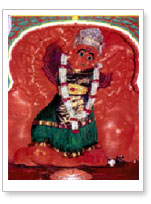








Nashik



pilgrimage
centers
Amarnath
Amritsar
Ayodhya
Badrinath
Bodha
Gaya
jyothirlingas
kanyakumari
Khajuraho
konark temple
Madurai
Mathura
Pandharpur
Pashupatinath
Puri Jagannath
Rameswaram
Rishikesh
Sarnath
Satya sai baba
Shani Shingnapur
Srikalahasti
Shri
Lakshmi GoldenTemple
Tirupathi
Vaishno Devi
SadGurus
Akkalkot
Maharaj
Shripad
SriVallabh
Dwadasa
jyotirlingas
Somanath
Shrishailam
Omkareshwar
Vaidyanath
Maha
Kaleshwar
Kashi
vishwanath
Bhimashankar
kedarnath
Nageshwer
Trimbakeshwar
Grishneshwar
Shakti
peethas
Sightseeing
Agra
Ajanta caves
Delhi
Ellora caves
Goa
Jaipur
Kashmir
Manasarovar
Foreign Trips










Naroshankar Temple
Situated in Panchavati area about 2km from Central Bus Stand, on
the bank of river Godavari - fondly called as ganga by Nasikites -
is Naroshankar Temple of Rameshwar built by Naroshankar
Rajebahaddur in 1747. The architectural style of the temple is
called "Maya". It is one of the most beautiful pieces of
architecture of the 18th century. Sculpture on the outer side of
the temple is stunning. It has rows of exuberant designs. One layer
is of decorative lacework. The next one is that of peacocks holding
bead garlands. In four directions are statues of the saints in
Padmasana. There is also an assembly of animals - tigers,
monkeys,elephants etc. This depicts that Hindu culture is not
limited only to human beings but also has relation with birds,
animals, trees, and nature in general. In its four corners are
umbrellas - called "Meghadambari" or "Barasati". One of them was
washed away in Godavari floods and only three are existing
presently. The surrounding fortification centres a "Bell house" in
the front part. The famous bell , called "Naroshankar Bell" is
fixed here. The bell is a victory memorial over
Portuguese.
Shree Sunder Narayan Temple
The Sundarnarayan temple is built by Gangadhar Yashwant Chandrachud
in 1756 at a distance of 1 km from Central Bus Stand. The entrance
of the temple is to the East. The architecture is attractive and
the round dome is made by little ornamental cordons. The arched
recesses are impressions of Mughal sclupture. The main deity is of
Lord Vishnu - also called Narayana. To the left and right are Laxmi
and Saraswati respectively. Fine design is carved on the stones of
the temple. On the road leading towards Godavari River there is
Badarika Sangam Pond. It is said that the king of Devgiri bathed
and performed rites in this pond. We also find a mention of this
pond in the holy book Dnyaneshwari. One remarkable thing about this
temple is that it is built at such an angle that on 21st March,
rays of the rising Sun first fall exactly upon the
idols.
Mukti Dham
Muktidham temple is situated in Nashik Road. Built by Late Shri
JayramBhai Bytco, is magnificient peice of architucture, made with
marble from Makran in Rajastan, and by Rajastani scluptors. Unique
to this temple are eighteen chapters of Geeta written on the walls.
You can also see the replicas of all the twelve Jyotirlingas over
here and also icons of all major Hindu Gods and Godesses. After
visiting this temple one gets a feeling of visiting all the four
Dhams in India. This temple is situated at a distance of 8 km from
Central Bus Stand
Shree Godavari Ramkund
The most important place in Panchavati is Ramkund, which is at a
distance of 1km from Central Bus Stand. It is so called because
Lord Rama is believed to have taken bath there. In Hindu culture
the body after dealth if dedicated to Fire and the ashes are then
flown in to Godavari, Ramkund is the place where ashes are set free
in the water.A dip in this sacred kunda is considered very
religous. Situated nearby is Gandhi Lake (Talav) having a memorable
monument made out of white marble, in memory of the Father of the
Nation. The ashes were dropped in Ramkund after Gandhiji passed
away on 30th January 1948.
Bhakti Dham
Bhakti Dham is sitiauted near Dindori Naka, at a distance of 2km
from Central Bus Stand. This place is renowned for various temples
built in the premises and all religious rituals, pujas and vidhis
are carried out in Bhakti Dham.
Shree Kapaleshwar Mahadev
Situated at a distance of 1km from Central Bus Stand, this temple
is one of the peculiar Mahadev Temples in Nashik.The most prominent
aspect regarding this temple is there is no idol of Nandi in front
ofLord Mahadev.Shravani Somvar(Monday) and Shivratri are the 2 days
when pilgrims gather in large numbers in this
temple..
Shree Ved Temple
The Ved Temple,situated at a distance of 1.5km from Central Bus
Stand, was built with the aim of studying Indian culture and Ved
and Puranas. A private trust of Mr Sarada founded the temple.The
temple is the example of modern interiors with Italian Marble. The
entrance to the temple is very large and attractive with glasses
and flood lights. Free training and education on Ved-Puranas is
given to students from all over India. The temple has the idols of
Shriram, Laxman and Sita. Along with them is the beautiful idol of
Guru Gangeshwaranandji.
Sita Gumpha (Cave).
Sita Gumpha is at a distance of 2 km from Central Bus Stand. It is
situated at the western side door of Kalaram Temple.Lord Rama's
wife, Sita dwelled at this place and King Ravan abducted her from
this place. The Shiv linga that she worshiped is still there in the
gumpha.There are five Banyan trees in this area and thus called
"Panchvati".
Dutondya Maruti.
This idol of Lord Maruti is placed on the bank of Godavari river
near Ramkund. This idol has two faces on eithe
sides.
Pandav Caves(Pandav Lani)
Pandav Lani is situated at a distance of 9km from Central Bus
Stand.These are three mountain peaks of Anjinagiri mountain
ranges.These caves were built by Jain Kings and are 2000 years
old.The engravings inside the gumpha are believedto be of Pandavas
of 17th Century and thus these caves are named as "Pandav
Caves".
These historical caves created B.C.100 to 110 are located on a
tableland on the Trivashmi Hill. Together,there are 29 caves &
may be training center for Buddha worshippers. Icons of Bhagwan
Gautam Buddha & Bodhisatva are wonderful crafted .During Jain
regime B.C. 1000 to 1100 these were home to Jain saints. Inside the
caves one can see idols of Buddha, Bodhisatva, Jain Tirthankar
Vrishabhdeo, Veer Kapibhadra and Ambikadevi. The cave complex
contains large caves which were the meeting places of the
disciples, where sermons were preached. The caves were well
designed with several water tanks chiseled into the rock.ral water
tanks chiseled into the rock.
Godavari Ghat, Nashik.
River Godavari flows through Nashik and its Northern part is known
as Panchavati. Lord Shri Ram and Sita along with Laxman stayed at
Panchavati during exile. There are five Banyan (Vad) trees and thua
the reason it is called Panchavati.Nearby is Sita Gumpha (cave)
where Sita stayed for some time.
Ramkund: The godavari river is one of the holiest places for Hindus
all over the world. The pious river bed has 24 tirthas(kund).
Ramkund, one of the holy kunds, measures 27 mtrs by 12 mtrs was
built in 1696 by Chitrarao Khatarkar and it is believed that Lord
Ram and Sita used to bathe in this Kund during their exile. Every
Hindu wishes his or her ashes to be immersed in Asthivilaya Tirtha
so a sto attain Moksha or liberation of the soul. The ashes of
various personalities has been immersed at Ramkund. Memorial (
Smarak) of Father of the Nation Mahtama Gandhi is located near
Ramkund.
Back
1 2
Advertisement
I am a text block. Click on me to drag me around or click a corner handle to resize me. Click the settings icon (it's the left one, looks like a cog) to change this text. You can type new text into me or cut and paste text from somewhere else. Click outside of me when you're done and any changes will be saved.





Site designed and Maintained by Harish





